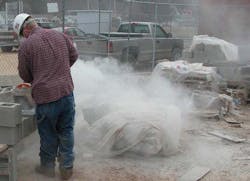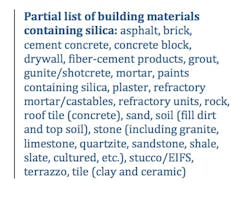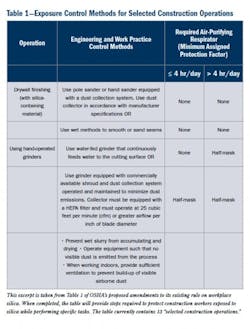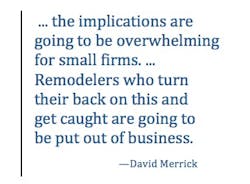In September 2013, an OSHA Notice of Proposed Rulemaking published in the Federal Register proposed the first changes in more than 40 years to its workplace regulations for Occupational Exposure to Respirable Crystalline Silica. OSHA is currently reviewing thousands of comments received from individuals and industry representatives, and is expected to release the final version of the rule in 2016. This month’s interview explores what the proposed changes are and how they will affect our industry.
This month featuring:
David Merrick, is president of Merrick Design and Build, a full-service remodeling company in Kensington, Md. In business for 25 years, the company has 26 employees. Merrick is a past chairman of the National Association of the Remodeling Industry (NARI) Metro-DC chapter and NARI National Governmental Affairs Committee, where he is still an active member.
Mark Paskell has been a remodeler and home improvement contractor for 25 years and a business coach and mentor for six years in his company, The Contractor Coaching Partnership. He is an educator on the design-build sales process and the lead carpenter system, and conducts OSHA 10, OSHA 30, and OSHA Fall Protection training. He is Chairman of the Board of Eastern Mass. NARI, where he is an active member of the government affairs committee.
Tom Swartz: Over the years, remodelers have had to deal with rules governing hazardous materials—most recently lead paint, but asbestos, radon, and mold also come to mind. Now OSHA is proposing a rule amendment affecting crystalline silica? What is crystalline silica?
Mark Paskell: Crystalline silica is a very fine dust created when we cut materials like concrete or work on surfaces that contain silica. It’s so fine—100 times smaller than a grain of beach sand—that it can easily be inhaled and lodge deep in your lungs. Exposure to high levels of crystalline silica over a long period of time can lead to dysfunction of the lungs and can cause a number of debilitating diseases, such as silicosis, lung cancer, and COPD (chronic obstructive pulmonary disease), most of which are untreatable and can be fatal.
David Merrick: When OSHA was founded [in 1970 as part of the Department of Labor], a rule on silica workers was one of the first regulations it adopted. This was prompted by one of the worst industrial incidents in American history, the 1927 Hawk’s Nest Tunnel Disaster. Union Carbide was digging a tunnel to divert the New River under Gauley Mountain in connection with a hydroelectric project. During the tunneling operation, workers discovered silica, a useful industrial commodity, so Union Carbide mined it to generate extra revenue. A lot has been written about what Union Carbide did or didn’t know, but the upshot is that the official number of deaths caused by silicosis and related diseases was almost 800, with other estimates ranging in the thousands. Since the silica rule was adopted, there has been a significant decline in deaths from silica. But part of the problem is that it’s hard to diagnose silica as the cause of a particular disease. It acts over the long term, so by the time someone dies, it’s often difficult to pinpoint silica as the cause.
Swartz: If in fact silica has been a problem ever since OSHA’s founding, and they’ve significantly reduced the number of deaths, then why all of a sudden is there a new regulation? What’s the big change now?
Merrick: The big change is in the paperwork. We call this a “new” regulation, but there already is a regulation on OSHA’s books that has been effective in reducing the mortality rate. OSHA is revising the existing regulation to add a lot of requirements similar to those for the lead RRP [Renovation, Repair, and Painting] rule.
Paskell: OSHA has said that there have been no changes to silica permissible exposure limits [PEL] since they were adopted in the early 1970s. The current PEL for silica is 250 micrograms per cubic meter (250 μg/m3) in the construction and maritime industries, and 100 μg/m3 for general industry. The new OSHA rule will reduce the PEL to 50 μg/m3 for all industries and workers.
Swartz: How does a remodeler know whether or not he’s generating enough dust to reach the PEL? Paskell: There are two components involved in measuring silica dust. The first has to do with the amount of dust being generated. This is determined by air monitoring, which is usually done by an industrial hygienist. Some companies—usually larger industrial operations—test the air themselves using the appropriate equipment and employees trained as “competent persons.” Under the new rule, the PEL will be reduced to 50 μg/m3. The other component is the duration of exposure. The exposure limit is affected by total exposure over an 8-hour period, a calculation called the time-weighted average or TWA. Taken together, the measured silica dust level and the time exposed over an 8-hour day will determine the actions a remodeler must take. OSHA also requires worker protection when an 8-hour TWA “action-level” of 25 ug/m3 is reached. That’s the point at which the amount of dust being generated is high enough that you have to act to protect your workers. Remodelers who have workers exposed at this level or above for 30 days or more will have to provide protection. If workers are below the exposure limit or aren’t exposed frequently enough, remodelers won’t have to do anything.
Swartz: How does a remodeling contractor measure that? It might be possible to do it in a manufacturing plant, but what about on a remodeling jobsite? And while I can see where it would be possible to take these measurements inside a home, how about outside?
Paskell: An air-monitoring device could be installed on the worker, clipped to his shirt in his breathing zone. As the work goes on, the device would measure the amount of silica being generated. The person in charge of the measurement would have to be a “competent person,” which is someone who is trained and certified to use the equipment. That could be a consultant or it could be an employee.
Swartz: I’m all for protecting the safety of the worker, but how practical is this? Do you see any remodelers you work with using these devices to measure silica? Seems like the cost would be exorbitant.
Merrick: OSHA is concerned only with worker safety, preventing death and injury. They don’t have much sympathy for cost. The problem for remodelers is that we are being lumped in with industries where the exposure is much higher. OSHA is trying to write one regulation that covers not just workers who are exposed all day every day, but also remodelers who are exposed only occasionally. Remodelers are definitely on the low end of exposure. As for how practical is it, OSHA recognizes that monitoring air is not always possible, especially in the construction industry, so they have come up with what is called “Table 1—Exposure Control Methods for Selected Construction Operations” (see sidebar), which is a list of “typical activities.”
Merrick: Right now there are 13 activities listed in Table 1, but one of the questions is how easy it will be to change, add to, or subtract from the table without having to revise the entire rule. In other words, instead of requiring each remodeling company to take measurements whenever they are doing something that generates silica dust, OSHA is going to come up with a list of activities that describes the work being done and the precautions that need to be taken. Requirements will vary depending on the task and on the amount of time the task takes. So if the person was doing something all day long, then at some point you might need to add a mask; if the work covered a longer time period, there would be other steps that would have to be taken. They’re trying to take exposure monitoring requirements and distill them into something remodelers can understand and implement. But they are going to have to come up with a huge list of tasks in Table 1.
Swartz: So, for example, as a practical matter, if you’re cutting concrete, you would use a face mask to protect workers. Would that solve the problem?
Merrick: In a one-time scenario, yes, that’s right. But if you’re cutting concrete all day for more than 30 days, then the regulations kick in. Medical monitoring and recordkeeping would be required.
Swartz: Can you address the recordkeeping that is going to be required? How long must they be maintained? And what’s going to go on when OSHA comes knocking and asks to see the records?
Paskell: Employers are required to have a safety program to protect workers. Let’s assume you have a worker exposed to silica dust for 8 hours per day for more than 30 days. That will require you to meet respiratory training and medical monitoring requirements. Respiratory training means employers will have to have employees cleared to wear a respirator before they wear it on the job. That entails having the employee tested for pulmonary function by a physician or a licensed life care professional. The employee will also have to be trained on proper care and use of a respirator. OSHA requires that employees must be given access to their medical records, so there is spillover into the Privacy Rule of HIPAA (Health Insurance Portability and Accountability Act of 1996). There are also other spillovers. For example, silica is considered a human carcinogen and therefore a hazardous substance. This triggers Global Harmonized System and Hazardous Communication training prior to employee exposure. On top of all that, because silicosis and related diseases develop over long periods of time, records must be kept for 30 years. I can’t imagine how a small remodeler, someone with four or five employees, is going to be able to comply.
Swartz: The HIPAA situation with a worker’s medical records is problematic, isn’t it? How do you protect yourself from liability for someone who was exposed on a different job, then comes to work for you? Who’s responsible? Paskell: To be 100% protected against a previous exposure, I would have a rigorous program in place that would show that given the work we do and the way we do it, there would not be a chance for silica exposure of that type. My environmental health and safety manual would have all of the paperwork in place, including a medical monitoring plan, a hazardous material plan, records of employee training, and evidence that I provide PPE (personal protective equipment) to workers.Merrick: Suppose you had someone who worked his whole life in a cement plant. He contracts silicosis and for whatever reason loses his job, then applies for a job with a remodeler. As potential employers, we are prohibited from asking for his medical records. So we hire him without knowing about his lung condition. Then if we put him on a job that generates even a small amount of silica, we’re suddenly exposed to liability for the disease caused by his former job. There’s no win here. We’re either breaking the HIPAA privacy rule or we have incomplete medical records or we’ve hired an employee who is unable to perform his new job due to the risk of further exposure.
Swartz: So where are we in the process? Has this change been finalized or is it just a proposed change? What is the likely time frame?
Merrick: First, remember that this is not a law; it’s a rule or regulation. Laws are made by legislators; this is coming from OSHA, which is an agency that has been authorized by the legislature to make rules for workplace health and safety. There was a comment period earlier this year. During that time, someone like you or I would pose a question and OSHA would respond with an answer; sometimes asking for more information from the questioner. Currently the comment period is closed, but thousands of comments have been made and we’re waiting for a response on most of them. The vast majority of comments from the remodeling industry came from the Construction Industry Safety Coalition, which is a group of more than 25 trade associations that have been working to change the rule. OSHA is reviewing all of those comments, a task it has described as “overwhelming,” so it has hired a consultant to expedite the process. The next official action would be for OSHA to notify the Office of Management and Budget that it is about to issue the rule. At the moment, there are only 13 work practices in Table 1, so OSHA still has a long way to go. It’s hard to imagine that it can get through the process anytime soon. The disturbing part of this is that the administration has said it wants to have the rule issued before President Obama leaves office. I take that to mean that the rule will be released whether it’s ready or not. This is out of the hands of Congress at the moment—OSHA has the power to do this. Congress is limited in how it would respond to this. So Congress can’t just say “Don’t’ do this.” But it does have the power to withhold funding to OSHA to implement the rule.
Paskell: Like David said, it’s out of the hands of Congress, and President Obama said recently in a press conference that he would not bend on worker safety. From a recent NARI government affairs meeting update, it appears that the final decision is estimated to be made by August 2016. The public comment period has concluded, so it’s likely we’ll see final summations shortly.
Merrick: Most of the other industries involved in this rule have already taken these actions. So they are just accepting it as a fact of life and a cost of doing business.
Swartz: Remodelers didn’t give RRP much credence back in 2010 because they didn’t think it applied to them. I don’t know of any remodelers who have a problem with silicosis, but from what you’re saying, it sounds like this silica dust rule could be as big as RRP.
Merrick: Yes, I think the implications are going to be overwhelming for small firms. If you don’t have a safety plan, you’re going to get fined. Remodelers who turn their back on this and get caught are going to be put out of business.
Swartz: So if I’m a typical remodeler struggling to make payroll next week, but I want to protect myself, what can I do?
Merrick: For the average remodeling company, very few workers will hit the actual limits. A drywaller may hit it, but carpenters won’t. So that means we’ll need to follow the recommended work practices in Table 1. So today, if I’m looking to buy a drill, I’m going to buy one with a vacuum attachment. And if I buy a vacuum, it’s going to have a HEPA filter.
Paskell: If remodelers can’t afford a safety monitoring test and required working protection and training, I think they will be better served by keeping their workers away from work that generates silica dust. Subcontract it to someone who has the safety training and protocols in place, and keep your workers away until that work is done. But the real solution is to put together a safety plan that covers all the bases. That way, if OSHA comes by for any reason, the paperwork is in place.
Swartz: What advice would you give today to remodeling contractors who need to know more about crystalline silica and how it relates to their business?
Merrick: From my perspective, the most important thing would be to support NARI and NAHB Remodelers in their lobbying efforts. They have been strong voices in the Construction Industry Safety Coalition, and they will continue to monitor the process and do what they can to change the outcome.
Paskell: I agree with that, and I would also recommend that remodelers go to the OSHA website, osha.gov, and dig into the material and educate themselves about silica. There’s a lot to learn. It can seem overwhelming, but you need to chip away at it. The OSHA website is full of tools that anyone can use to learn and understand what they are required to do. And there are templates at the OSHA website that you can use to build a written safety plan. It will take some time, but you can put it together yourself. OSHA also has an education outreach program. A lot of people are afraid to call OSHA, but they do have an education arm designed to help people. PR
More Information
OSHA’s Silica Rulemaking Web page: includes several tabs with links to OSHA Fact Sheets, “Archived Web Chat,” and other resources for information about the silica rule
OSHA’s Notice of Proposed Rulemaking (NPRM) for Occupational Exposure to Respirable Crystalline Silica





